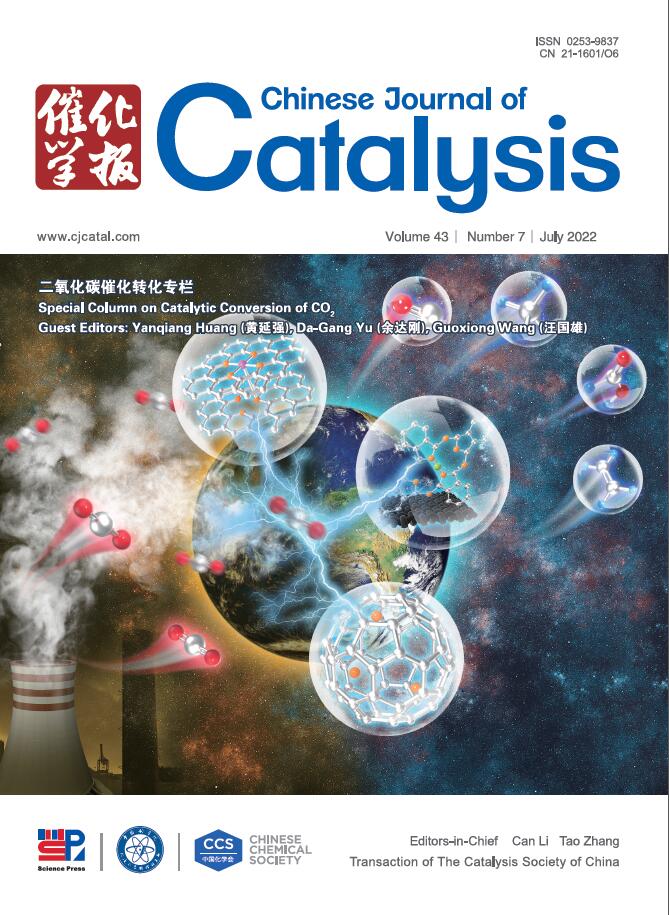First-principles microkinetic simulations revealing the driving effect of zeolite in bifunctional catalysts for the conversion of syngas to olefins
IF 17.7
1区 化学
Q1 CHEMISTRY, APPLIED
引用次数: 0
Abstract
Direct conversion of syngas to light olefins (STO) on bifunctional catalysts has garnered significant attention, yet a comprehensive understanding of the reaction pathway and reaction kinetics remains elusive. Herein, we theoretically addressed the kinetics of the direct STO reaction on typical ZnAl2O4/zeolite catalysts by establishing a complete reaction network, consisting of methanol synthesis and conversion, water gas shift (WGS) reaction, olefin hydrogenation, and other relevant steps. The WGS reaction occurs very readily on ZnAl2O4 surface whereas which is less active towards alkane formation via olefin hydrogenation, and the latter can be attributed to the characteristics of the H2 heterolytic activation and the weak polarity of olefins. The driving effect of zeolite component towards CO conversion was demonstrated by microkinetic simulations, which is sensitive to reaction conditions like space velocity and reaction temperature. Under a fixed ratio of active sites between oxide and zeolite components, the concept of the “impossible trinity” of high CO conversion, high olefin selectivity, and high space velocity can thus be manifested. This work thus provides a comprehensive kinetic picture on the direct STO conversion, offering valuable insights for the design of each component of bifunctional catalysts and the optimization of reaction conditions.
第一性原理微动力学模拟揭示了沸石在合成气制烯烃双功能催化剂中的驱动作用
合成气在双功能催化剂上直接转化为轻质烯烃(STO)已经引起了广泛的关注,但对反应途径和反应动力学的全面理解仍然是难以捉摸的。本文从理论上研究了典型的ZnAl2O4/沸石催化剂上直接STO反应的动力学,建立了一个完整的反应网络,包括甲醇合成和转化、水气转换(WGS)反应、烯烃加氢等相关步骤。WGS反应在ZnAl2O4表面极易发生,而对烯烃加氢生成烷烃的反应活性较低,这与ZnAl2O4表面的H2异裂解活性和烯烃极性较弱有关。通过微动力学模拟验证了沸石组分对CO转化的驱动作用,该驱动作用对反应温度、反应速度等条件敏感。在氧化物和沸石组分之间固定的活性位点比例下,高CO转化率、高烯烃选择性和高空速“不可能三位一体”的概念就可以得到体现。这项工作为STO直接转化提供了一个全面的动力学图景,为双功能催化剂各组分的设计和反应条件的优化提供了有价值的见解。
本文章由计算机程序翻译,如有差异,请以英文原文为准。
求助全文
约1分钟内获得全文
求助全文
来源期刊

Chinese Journal of Catalysis
工程技术-工程:化工
CiteScore
25.80
自引率
10.30%
发文量
235
审稿时长
1.2 months
期刊介绍:
The journal covers a broad scope, encompassing new trends in catalysis for applications in energy production, environmental protection, and the preparation of materials, petroleum chemicals, and fine chemicals. It explores the scientific foundation for preparing and activating catalysts of commercial interest, emphasizing representative models.The focus includes spectroscopic methods for structural characterization, especially in situ techniques, as well as new theoretical methods with practical impact in catalysis and catalytic reactions.The journal delves into the relationship between homogeneous and heterogeneous catalysis and includes theoretical studies on the structure and reactivity of catalysts.Additionally, contributions on photocatalysis, biocatalysis, surface science, and catalysis-related chemical kinetics are welcomed.
 求助内容:
求助内容: 应助结果提醒方式:
应助结果提醒方式:


